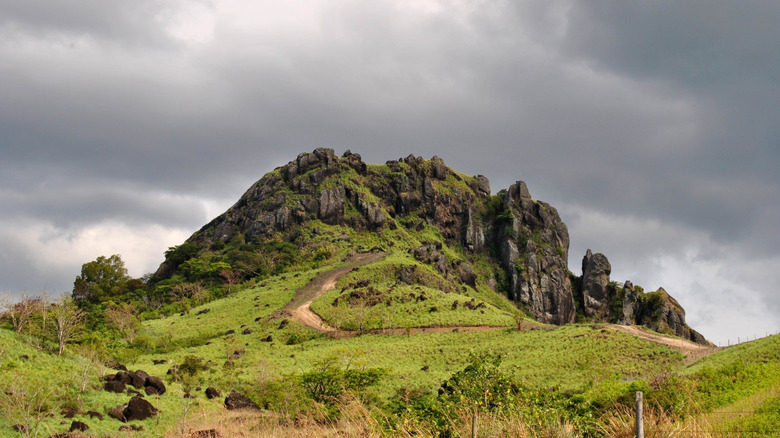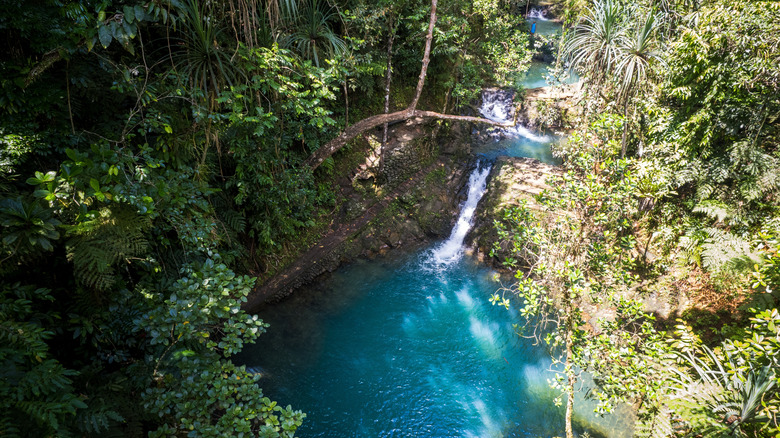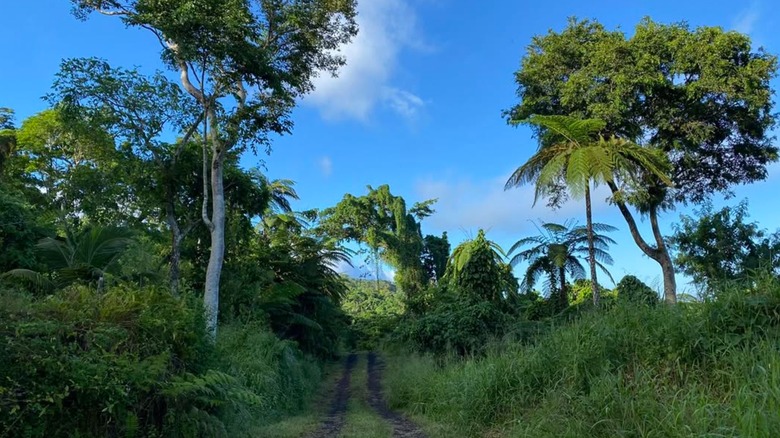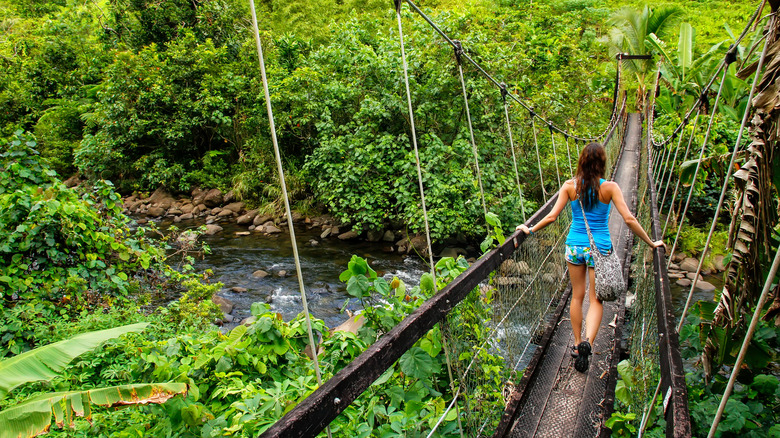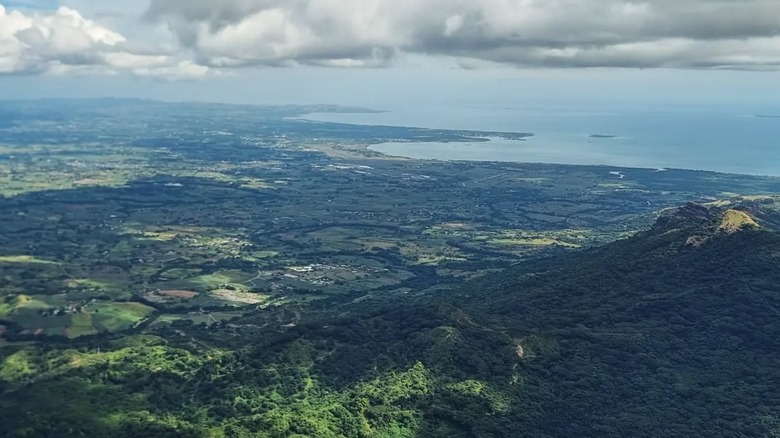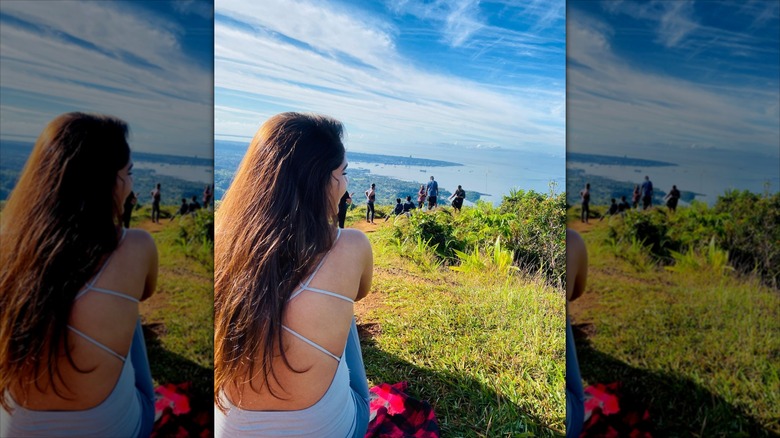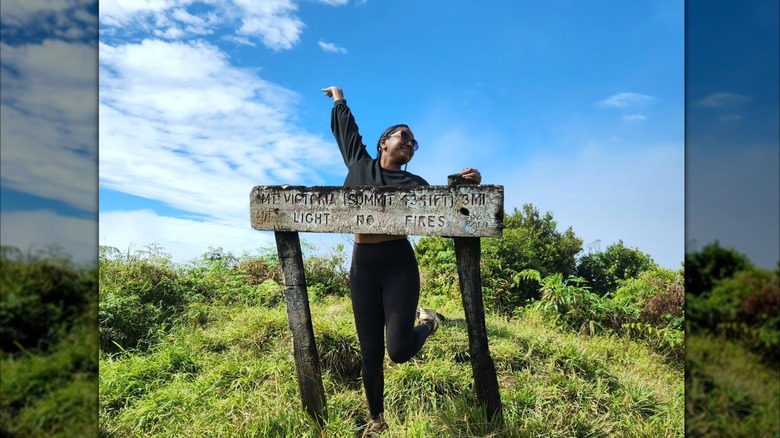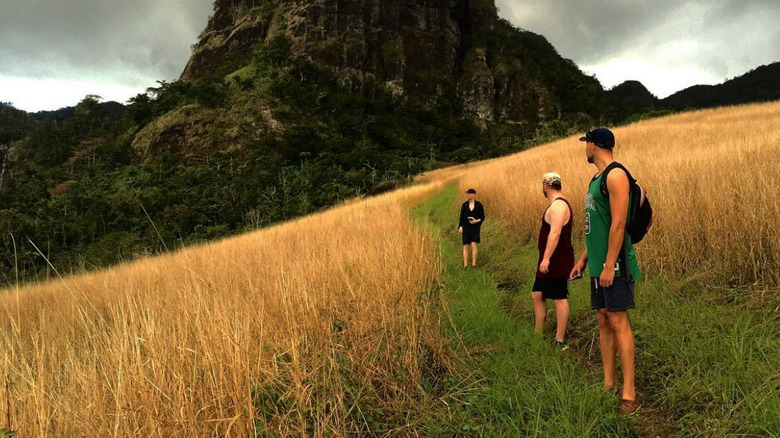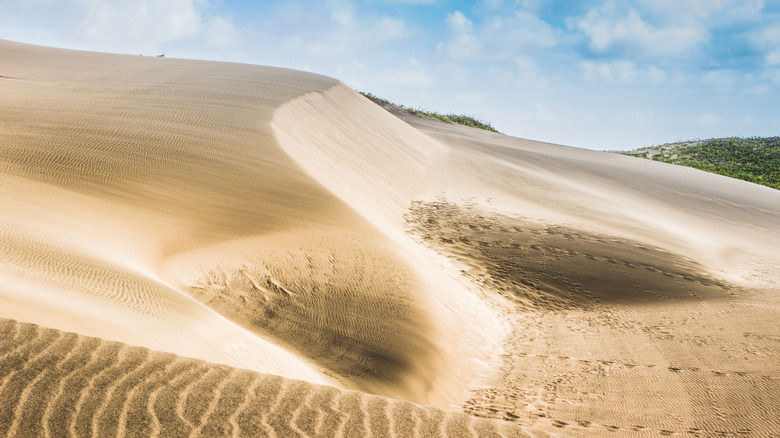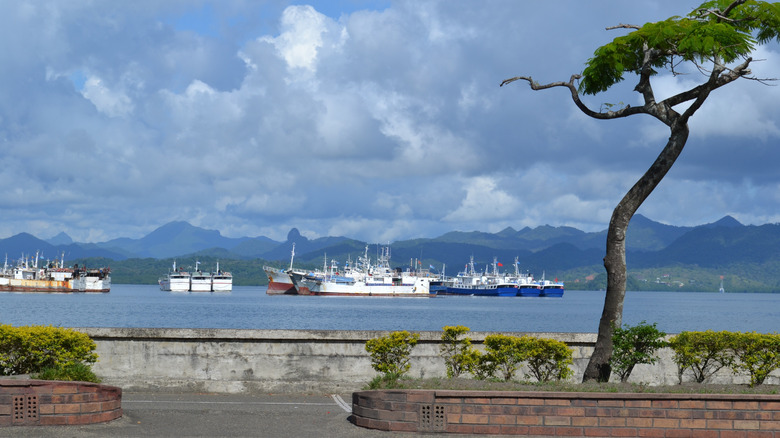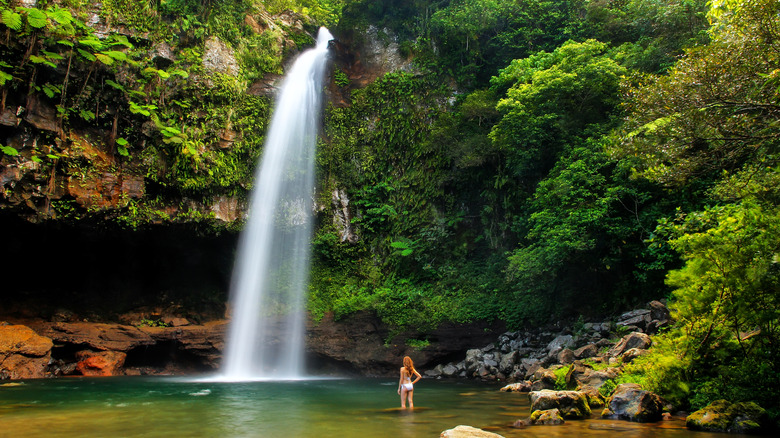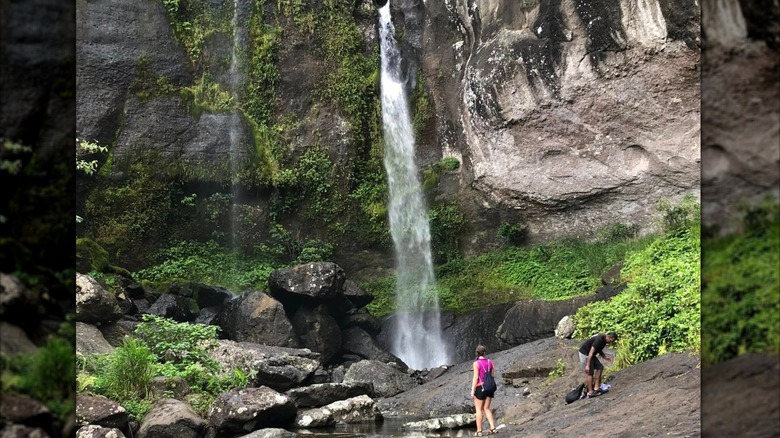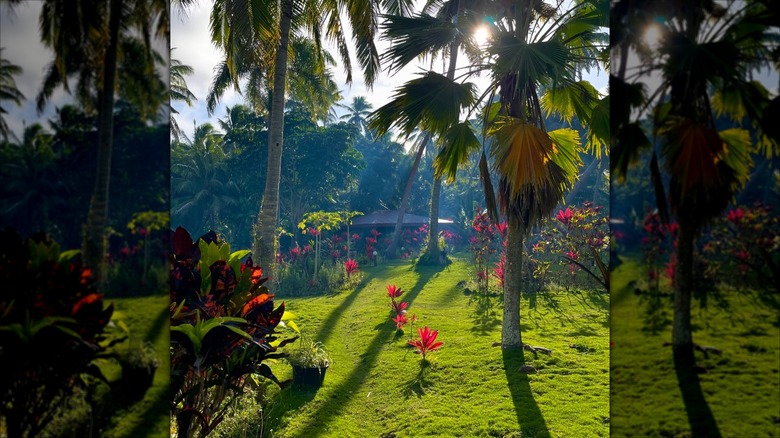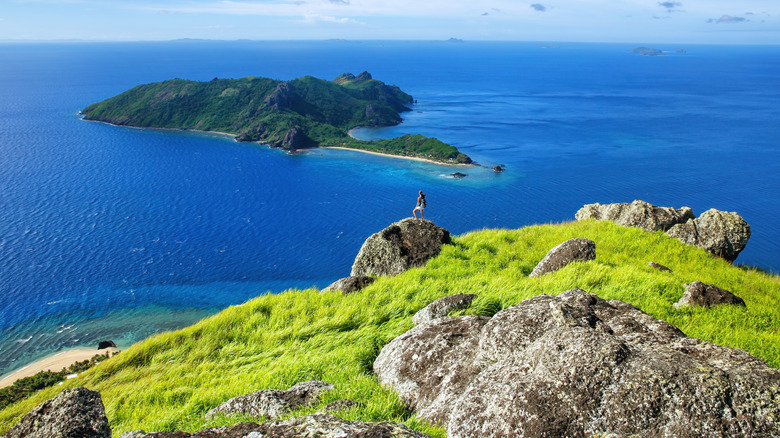Fiji's 12 Best Walks And Hiking Trails, According To Travelers
This nation in the South Pacific presents an archetypal image of a tropical island paradise. Many islands, in fact, since Fiji is an archipelago of over 300 isles, many of which are uninhabited. Within that large assemblage, there is plenty of choice on offer, with islands to suit any travel style. Travelers that make their way to the country will find striking beaches with tall palms, mountains interiors covered in dense forest and jungle, and friendly locals that are justifiably proud of their unfussy way of life.
While many visitors come here for the sea and sand, the fantastic diving, the incredible places to snorkel, or even the best overwater bungalows, the nation is also a great spot for hikes and walks. Scouring hiking-focused sites like AllTrails and recommendations from the official Fiji tourism website, we've put together the best of them. So pack those bags, read up on Fiji before boarding the plane, and get ready for the adventure of a lifetime.
Colo-I-Suva Forest Park
Located in the southeast of the island of Viti Levu, close to Suva (Fiji's capital), Colo-I-Suva Forest Park allows visitors to explore a rainforest environment. There are trails around this pocket of greenery, and some bring travelers to the reserve's many waterfalls. For serious trekkers who want the kinds of trails that are only for experienced hikers, the walks there will feel easy. There are about 4.3 miles of marked trails and less obvious tracks that wind through the bush for the more intrepid adventurers. After a session of hiking, visitors can cool off in the pools dotted around the terrain. If you've still got some energy, you could look out for the rope swings and use them to plunge into the clear shallows of Waisila Creek.
The park is also a good choice for birdwatchers thanks to the variety (and numbers) of avian inhabitants, including spotted fantails and scarlet robins. "The trail to the pools and waterfalls (we went down to the lower falls area) will not be as easy as you may think and we recommend sneakers or hiking boots," explains a Tripadvisor contributor. "The water was extremely refreshing," they say, "amazingly enjoyable and a not-to-be-missed experience." However, travelers should also be careful when visiting this park. A U.S. Department of State advisory notes that crime occurs on the trails, with robbers grabbing bags, purses, and phones in areas where foreign visitors are known to be present.
Des Voeux Peak and Lake Tagimoucia
Climbing Des Voeux Peak on the island of Taveuni means disappearing into a realm from another dimension. The deep, dense rainforest is home to thick bush and ferns, hard-to-spot birds like the blue crested flycatcher and the orange dove, and one of the rarest flowers on the planet. The Tagimoucia — which has a blooming season from October to January and is the country's official flower — only grows in Lake Tagimoucia. This volcanic crater lake is accessible from Des Voeux Peak and is arguably the ultimate prize of this hike. The flower ephemerally blooms around the lake with delicate red and white petals and is tied to a Fijian legend. According to lore, the flowers were created by the tears of a princess who fled to the forest to avoid the fate of an arranged marriage — "tagi" and "moce" mean "tear" and "sleep" in Fijian.
Hikers are advised to only attempt the hike with a certified guide, especially if continuing on to the crater lake, as the trail isn't always obvious and is only faintly marked. If you do hike Des Voeux Peak, the exertion is worth the effort. Winding through the dense jungle is like exploring a mystical realm, and the views from the summit take in Lake Tagimoucia and the Lau island chain. This is a full-day excursion, taking at least five or six hours, and the walk includes some steep ascents.
Lavena Coastal Walk
This is definitely a hike that visitors can do on their own. One Tripadvisor traveler confirmed as much, saying, "Nice coastal hike ending in a serene waterfall swim to reward you at the end. Trail is pretty well maintained, we managed without a guide." The name of the hike hints that this is more a leisurely stroll than a calf-burning slog up the side of a vertiginous peak. Along the route (which is about 6 miles roundtrip), hikers will see beaches and forests. Lavena Coastal Walk is situated in Bouma National Heritage Park, one of the prime areas of nature on the island of Taveuni, known locally as the Garden Island.
The hike begins in Lavena village, set at the end of a point on the east coast of the island. Hikers won't have to worry about rocky climbs or tricky descents, as the trail is relatively flat all along its route. It skirts beaches, small areas inhabited by locals, plantations, and sections of rocky coast. One part requires hikers to cross a stream, though there is a rope to make the task easy. The trail hugs the coastline for sections but veers toward the interior at the end, with a gorge opening up to the pretty Wainibau Waterfall. After a steamy hike, cooling off in the cascade is a fine reward. During the rainy season of November to March (the worst time to plan your Fiji vacation), the trail conditions are likely to be slippery and more hazardous.
Mount Batilamu
Located on Viti Levu and less than an hour by car from Nadi International Airport, Koroyanitu National Heritage Park is a slice of natural bliss, unfurling over 13 square miles of the island's interior. Within the park's confines, travelers find Mount Batilamu, one of the highest mountains in the country and a peak that many visitors come to climb. "WHAT A HIKE!!! It was absolutely amazing to get up into the mountain," beams one Tripadvisor commenter. "The views are like no other, absolutely stunning at the top." Hikers can expect a steep route up to the top, but the summit promises inspiring vistas of the Nadi Valley, the rolling Pacific Ocean, the western lip of the island, and the Mamanuca and Yasawa archipelagoes.
The experience begins in the visitor center in Abaca village, where hikers pay the entry fee and perhaps scout a guide, though many visitors arrange guiding services in advance. The trek up takes about three to four hours and is a pretty relentless upward climb on a trail in good condition. Near the top, visitors will find a small hut, where they can decompress before the final push, a 15-minute walk to the best viewpoint. While this is a very feasible day hike, some travelers prefer to overnight in the hut, which has basic supplies and bunk beds. That way, they can watch the sunset and sunrise from the summit and not feel rushed on either leg.
Mount Korobaba
One reviewer on Google has some sage advice for anyone looking to hike up Mount Korobaba. "Starting early morning will help to make it easy. Try to avoid rainy weather as part of the trail is extremely slippery. View from the top is worth spending two hours to reach the top." The mountain is about 1,300 feet high, and if that doesn't seem very taxing, the way up will definitely test out your calves and quads. The hike begins near the village of Lami, and while the trailhead might be hard to find, it's near an old cement factory, and locals will be able to show travelers the location. Listen carefully, and you'll hear not only the soft thud of your footsteps but the mellifluous chirps and chimes of birdsong.
At the top, the views open in every direction, and take in the ridges and plains of Viti Levu, the sea, the urban sprawl (by Pacific Islands standards) of Suva, and even the islands of Beqa and Yanuca. The breeze is a constant at the top and a welcome contrast to the heat, allowing hikers to cool off. Another great opportunity to cool down presents itself at the end of the hike near the mountain's base, where pools and waterfalls are the perfect postscript to hours of exertion.
Mount Tomaniivi
If you are the kind of traveler who loves challenging yourself, hiking Mount Tomaniivi should certainly be on your list. This is Fiji's highest mountain, and the trek to the top is a hike to the top of the world. Also known as Mount Victoria (its colonial name), this peak sits in north-central Viti Levu, south of a stretch known as Suncoast. The mountain tops out at 4,344 feet above sea level, and trekkers will pass through cloud forests and areas thick with humidity on their way up to the summit.
"The first half of the climb to Mt. Tomaniivi is gentle, and the second half begins to climb. The road is very muddy," notes a Google reviewer. "It is also a good choice to wear non-slip gloves, because you will need to hold on to rocks and trees on the way." Hikes typically start in Navai, and visitors are expected to use a guide to complete the hike. The climb is steep, with an elevation gain of nearly 2,000 feet, and features plenty of slick mud and rocks along the route. At the summit, a wooden sign showing the name of the mountain and its elevation is a good spot to take a selfie.
Savu-i-One Waterfall
Another Koroyanitu National Heritage Park excursion, this hike takes three hours. This is a relatively straightforward walk and nowhere near as challenging as Mount Batilamu, but it requires that visitors pay the entry fee of Fijian $25 (about US$ 11) for entry into the park. Trips begin at the visitor center.
Birdwatchers will find particular excitement in the avian life, with masked shining parrot, red avadavat, and the Fiji parrotfinch among the species that can be spotted in the wilds. The walk itself is 3 miles in length, and trekkers can expect an elevation gain of 1,230 feet. The path is sometimes wide and grassy as it climbs towards the falls. The cascade itself is high and slender, plummeting down a sheer face of rock while dense rainforest spreads in all directions around it. Streams and pools along the way are perfect places to take a break and cool down.
Sigatoka Sand Dunes National Heritage Park
"It is a beautiful hike through beautiful scenery. The hike is moderate," explains a Tripadvisor reviewer. "Best to go when the park opens at 8 a.m. to avoid the noon-day sun and high humidity. A must see." Visitors will witness giant dunes here, some as high as 200 feet. There are a couple of hikes in the park, neither of which is especially strenuous. They range between one and two hours in length, and either will bring hikers close to butterflies, birds, wildflowers, flying foxes, and massive mountains of sand. The park is along the Coral Coast and close to where the Sigatoka River meets the sea.
The park isn't only covered in dunes but also encompasses realms of grassland and sections of forest. There is also some anthropological interest on-site, with old pieces of pottery and ancient tools hinting at the human life that once existed in the area thousands of years ago. Animal lovers should look out for giant orb weavers, fruit bats, and goshawks. One word of warning: The park is on the island's southwest coast, and the sea breeze can sometimes lift fine sand off the dunes and right into your face, which is never fun. If you do find yourself covered in sand, consider heading to the beach that book-ends the park and sliding into the shallows to wash off.
Suva Sea Wall
A walk along the Suva Sea Wall is a fabulous choice if you're looking for somewhere to take in the rich parade of coastal city life, as this Google commenter opines. "Great hangout spot during the day and night time as well. Apart from doing some exercise along this stretch, it's good to chill out with meals." This leisurely walking route along the waterfront of Fiji's capital city brings travelers to views of the water and past pretty greenery. Among the highlights are the Takashi Suzuki Garden's manicured lawns and small landscaped displays. A walk along the sea wall allows visitors to experience daily life like a local and also enjoy sunsets at the end of the day. The walk shadows the main road of Elizabeth Drive.
Take an amble on a bright morning, and you will see Fijians using the exercise equipment peppered along various points, benches where locals sit and chat or breathe in the Pacific air, kids carousing in the playgrounds, and families picnicking in the bures (thatched huts). Active types might jog or bike along the path, but it's equally a hub of relaxation and the slow life. Best of all, if you are feeling hungry or thirsty, there are plenty of places to eat and drink a short walk away. However, tourists should be cautious when undertaking this walk in the dark; the U.S. Department of State notes that assaults and thefts have taken place around the seawall at night.
Tavoro Falls
The popular Tavoro Waterfall Trail is within Bouma National Park on Taveuni Island (Fiji's third-largest) and brings visitors close to fine natural offerings. Hikers can walk among legions of coconut trees, hear the uplifting chirping of songbirds, and find freshwater pools for a refreshing dip. There are actually three waterfalls to see on the trail (sometimes referred to as the Bouma Waterfall Trail), and this Tripadvisor contributor explains the benefit of seeing all three. "Loved this place especially Falls number two and three; number one was filled so we hiked to number two was just like 'wow' and it was empty, further hike to number three and it was 'amazing' totally worth the hike and beautiful views from the climb as well."
The first part of the trail starts as a clear, easy concrete walkway, bringing travelers to the fall that gives the trail its name. This part is relatively easy, about 15 minutes of simple walking along a clear walkway flanked by fruit trees, but the real prize lies ahead, and those who persevere will find a more challenging hike. The rainforest gets wilder, and you may have to cross streams at some points. To get to the second fall, hikers might need to walk 30 minutes or so past Tavoro Waterfall, while the third waterfall is another 30 minutes beyond that. Make sure to look out for the purple crabs that sometimes appear near the falls.
Tunu Tunu Waterfall
The third hike in Koroyanitu National Heritage Park, this two-hour trip terminates at a lovely cascade where cooling off with a swim may feel like the most magical thing in the world. The hike weaves through slices of rainforest and begins at the visitor center in Abaca village (as do the other hikes in the park). The village itself has a slightly eerie genesis. It was formerly known as Nagaga, with about 500 inhabitants. In 1931, a vast landslide leveled the village, and most of the people living there perished.
Only three men survived, as did a mysterious carving in rock of the letters "A B C". This formed the basis of the new village's name: Abaca. The church in the village contains information about this devastating episode in local history. The trail to the Tunu Tunu Waterfall is a little over 2.5 miles long and only gains about 790 feet in elevation. Completing it in two hours isn't difficult, and along the way, hikers will notice grassy climbs, rocky ascents, forested mountain ridges, and ocean views.
Vatalutu Trail
The island of Kadavu is off the beaten path and promises a relaxing vacation. It is a jagged island with a heavily indented shoreline, sits due south of Viti Levu, and is a dream destination for nature lovers. Where to begin? There are no bad options, but the gorgeous Vatalutu Trail is fantastic. The trek lasts about three hours and winds its way around a slice of the island's northeast coast, rumbling through rainforests and the lush interior before depositing visitors on a quiet, remote beach.
Kadavu's dense rainforests and mangroves are home to four endemic birds, among them the yellow-headed whistling dove and the crimson shining parrot, a bird with feathers in vibrant hues of red, blue, and green. And a short distance northeast of Kadavu, the Great Astrolabe Reef is a prime spot for snorkeling and diving, with one area renowned for its wealth of manta rays.
Methodology
Fiji might be known for its wealth of beaches and sumptuous seas, but there is much to admire around its interior. To find the best hikes and walks on the islands, we started with Fiji's official tourism site, the Fiji-centric blog Fiji High, and Alltrails, an interface that specializes in hiking trails all over the world. We looked for trails and walks that recurred throughout our sources and received positive reviews for their scenery, ambiance, or ability to test a hiker. To beef up each entry, we tried to add personal experiences from people who have completed each trail, using quotes from traveler blogs or sites like Tripadvisor and Google.
